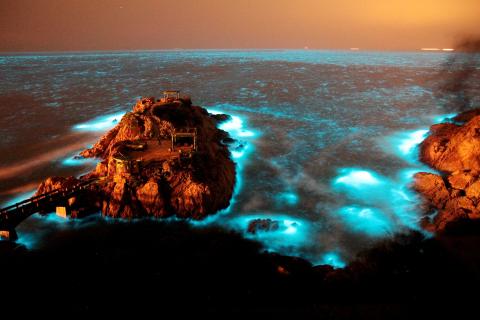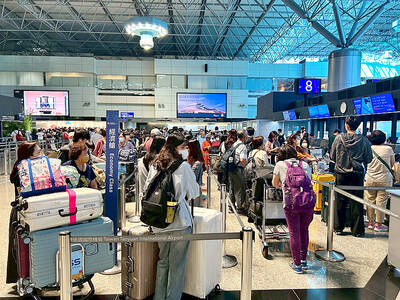A species of glowing flagellate protists called Noctiluca scintillans, also known as sea sparkles, has been identified as one of the light-emitting organisms responsible for creating Mastu’s bioluminescent blue tides, a National Taiwan Ocean University research team said on Monday.
Similar to the red tide in the Gulf of Mexico, the blue tide of Matsu — also known as “Blue Tears” — is a naturally occurring nighttime phenomenon of blue luminescence in the sea near Matsu between April and August and is a major tourist attraction.
Chiang Kuo-ping (蔣國平), director of the university’s Center of Excellence for the Oceans, said his team had confirmed that the protists known as sea sparkles are one of the main species causing the blue tides.

Photo courtesy of Lienchiang County
Using capillary tubes with the aid of microscopes, researchers were able to extract the glowing organisms from samples they took from the ocean, Chiang said, adding that a university lab had grown sea sparkles in captivity, completing one of its research objectives.
Sea sparkles are a species belonging to a subset of single-cell protists called dinoflagellates, and while about half of all dinoflagellates are photosynthetic organisms, the other half — including sea sparkles — are predators that survive by devouring smaller creatures, Chiang said.
An individual sea sparkle is a transparent, spherical organism with a diameter of between 0.2 millimeters and 2mm, a mouth at the rear of a ventral crevice and a large forward-facing tentacle for strong-arming prey, he said.
Tsai Sheng-fang (蔡昇芳), a research fellow at the center, said that sea sparkles’ light-emitting mechanisms are found in their cellular membranes, with an individual light source being between 0.5 micrometers and 1.5 micrometers.
An individual sea sparkle possesses roughly 10,000 of these light sources, Tsai said.
Each light source has three biochemical components: an oxidase, a protein structure and luciferin — the light-emitting agent, Tsai said, adding that when a sea sparkle glows, the protein structure “grabs” the luciferin and attaches it to oxidase, leading to oxidation and the production of a blue light.
“Each light source is capable of releasing about 100,000 photons in an estimated 80-millisecond burst, creating a sparkling effect in the sea that is quite different from the long-exposure photographs taken during blue tides, which present a false image of solid blue light that is not what the naked eye sees during an event,” he said.
University president Chang Ching-fong (張清風) said that the facility acknowledged Lienchiang County Commissioner Liu Tseng-ying (劉增應), County Councilor Chang Yuan-chiang (張永江) and Chinese Nationalist Party (KMT) Legislator Chen Hsuen-sheng (陳雪生) for supporting the university’s bid to open a new campus on Matsu next year.
The Matsu campus is to have three departments and students are to spend three academic years at the university’s Keelung Campus and one on Mastu, he said.
The university received a NT$50 billion (US$1.55 billion) grant from the Ministry of Education’s Aim for the Top University Plan to fund the university’s five-year project to research the blue tide phenomenon, Chang Ching-fong said.

Three batches of banana sauce imported from the Philippines were intercepted at the border after they were found to contain the banned industrial dye Orange G, the Food and Drug Administration (FDA) said yesterday. From today through Sept. 2 next year, all seasoning sauces from the Philippines are to be subject to the FDA’s strictest border inspection, meaning 100 percent testing for illegal dyes before entry is allowed, it said in a statement. Orange G is an industrial coloring agent that is not permitted for food use in Taiwan or internationally, said Cheng Wei-chih (鄭維智), head of the FDA’s Northern Center for

The Chinese military has built landing bridge ships designed to expand its amphibious options for a potential assault on Taiwan, but their combat effectiveness is limited due to their high vulnerability, a defense expert said in an analysis published on Monday. Shen Ming-shih (沈明室), a research fellow at the Institute for National Defense and Security Research, said that the deployment of such vessels as part of the Chinese People’s Liberation Army (PLA) Navy’s East Sea Fleet signals a strong focus on Taiwan. However, the ships are highly vulnerable to precision strikes, which means they could be destroyed before they achieve their intended

About 4.2 million tourist arrivals were recorded in the first half of this year, a 10 percent increase from the same period last year, the Tourism Administration said yesterday. The growth continues to be consistent, with the fourth quarter of this year expected to be the peak in Taiwan, the agency said, adding that it plans to promote Taiwan overseas via partnerships and major events. From January to June, 9.14 million international departures were recorded from Taiwan, an 11 percent increase from the same period last year, with 3.3 million headed for Japan, 1.52 million for China and 832,962 to South Korea,

REWRITING HISTORY: China has been advocating a ‘correct’ interpretation of the victory over Japan that brings the CCP’s contributions to the forefront, an expert said An elderly Chinese war veteran’s shin still bears the mark of a bullet wound he sustained when fighting the Japanese as a teenager, a year before the end of World War II. Eighty years on, Li Jinshui’s scar remains as testimony to the bravery of Chinese troops in a conflict that killed millions of their people. However, the story behind China’s overthrow of the brutal Japanese occupation is deeply contested. Historians broadly agree that credit for victory lies primarily with the Chinese Nationalist Party (KMT)-led Republic of China (ROC) Army. Its leader, Chiang Kai-shek (蔣介石), fled to Taiwan in 1949 after losing a